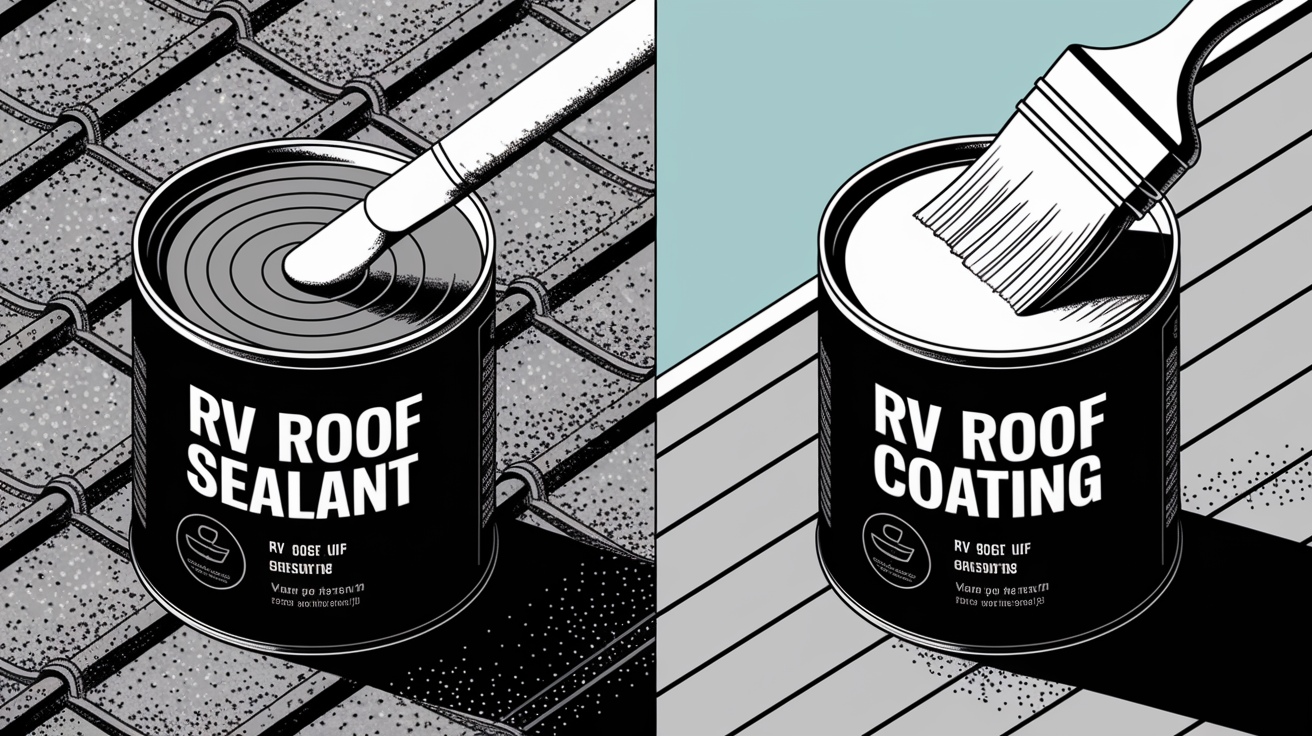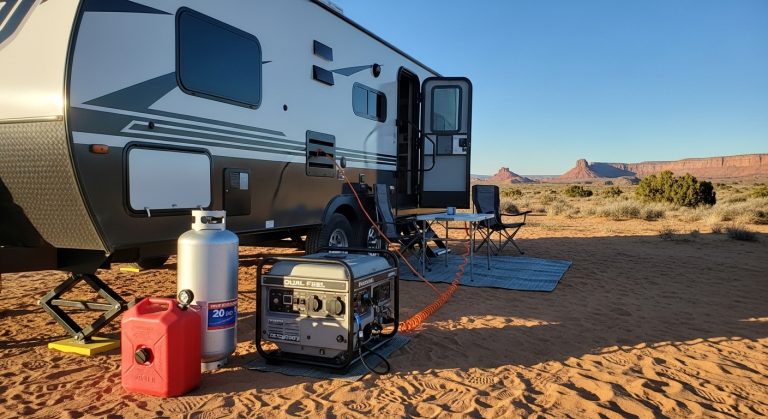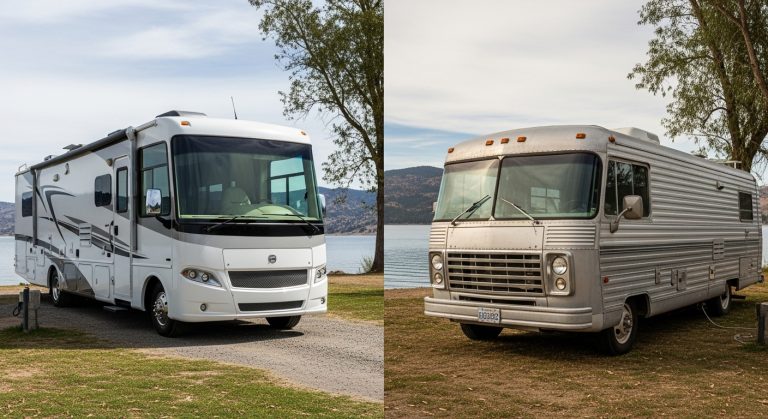RV roof sealants are used to fill gaps and repair leaks around seams, vents, and skylights, while coatings apply a protective layer over the entire roof surface. Sealants cure to flexible rubber and require regular maintenance, typically demanding reapplication more frequently than coatings. Coatings, like silicone or acrylic, offer superior durability and energy efficiency, lasting 10 to 30 years with proper care. To understand the specific benefits and applications of each, keep exploring further.
Key Takeaways
- RV roof sealants are designed for specific repairs, filling gaps and leaks, while coatings provide a protective layer across the entire roof surface.
- Sealants typically require more frequent reapplication compared to coatings, which can last 10 to 30 years with proper maintenance.
- Coatings offer superior durability and UV resistance, helping to reduce heat absorption and enhance energy efficiency.
- Application methods differ: sealants are applied with caulking guns, while coatings use rollers or brushes for broader coverage.
- Sealants target localized issues, while coatings prevent leaks and promote overall roof longevity and lower maintenance costs.
Definition and Purpose of RV Roof Sealants and Coatings
When it comes to maintaining your RV, understanding the roles of roof sealants and coatings is essential.
Sealants are specifically designed to fill gaps and repair leaks around seams, vents, and skylights. You apply them to targeted areas where leaks already exist or are likely to occur. However, sealants require regular maintenance, as they can crack and lose effectiveness over time. This is particularly important because roof problems are commonly noted in RV inspection reports, highlighting the necessity of keeping sealants in good condition.
Sealants effectively fill gaps and repair leaks but need regular maintenance to prevent cracking and loss of effectiveness.
On the other hand, coatings provide a protective barrier across the entire roof surface, shielding it from UV rays and weather. They help prevent leaks by creating a waterproof layer, reducing overall maintenance needs. While sealants are cost-effective for small repairs, coatings offer long-term durability and extensive protection for your RV roof.
Materials and Composition of Sealants and Coatings
Understanding the materials and composition of RV roof sealants and coatings helps you make informed decisions about maintaining your vehicle.
Sealants like TREMPRO are single-component, curing to a flexible rubber upon moisture exposure. Polyurethane-based sealants provide robust protection but are less flexible once cured. In contrast, coatings, such as acrylics and silicones, offer better flexibility and durability, with silicone coatings excelling in UV resistance. Liquid Rubber coatings deliver a long-lasting finish, while rubber sheeting provides insulation. While sealants target specific repairs, coatings cover entire surfaces. Both types guarantee environmental resistance, but you’ll find that coatings typically require less maintenance and offer longer-lasting performance, making them a cost-effective choice for your RV roof. Additionally, sealants like TREMPRO are highly flexible, making them ideal for withstanding movement and moisture.
Application and Installation Processes
Before diving into the application and installation processes of RV roof sealants and coatings, it’s crucial to prepare the surface properly. Follow these steps for effective preparation:
- Clean the Surface: Confirm the roof is free of dirt, dust, and old sealants to promote adhesion.
- Check Weather Conditions: Apply materials only in suitable weather—avoid wet or extremely cold conditions.
- Inspect for Damage: Look for any roof damage that needs repair before application, as regular inspections are essential to prevent leaks.
For application, use a caulking gun for sealants around fixtures and rollers or brushes for coatings. Always use masking tape for sensitive areas.
Remember to allow adequate curing time and inspect your work for uniformity and adhesion after application to guarantee longevity and effectiveness.
Durability, Longevity, and Maintenance Considerations
Proper preparation is key to ensuring the effectiveness of RV roof sealants and coatings, but their durability, longevity, and maintenance requirements play a significant role in overall performance.
Coatings generally provide superior durability due to their high-quality materials and better adhesion, ensuring a more uniform protective layer against leaks. While sealants may last shorter periods and require more frequent reapplication, coatings can endure 10 to 30 years with proper maintenance. Regular maintenance is crucial, as the rubber roof acts as a barrier against water damage, mold, and mildew, significantly affecting the roof’s overall health.
Regular cleaning and inspections are vital for both, but coatings may only need recoating every 5-10 years. Environmental factors can affect longevity, so establishing a maintenance schedule is essential to prolong the lifespan of your chosen option, allowing you to enjoy your RV with peace of mind.
Energy Efficiency, Cost, and Specialized Use Cases
When considering RV roof options, energy efficiency, cost, and specialized use cases are critical factors that can greatly impact your decision.
Here’s what you need to know:
- Energy Efficiency: Silicone coatings can reflect up to 88% of UV rays, reducing heat absorption and lowering HVAC loads. This is essential as roof sealant acts as a barrier against water intrusion, contributing to overall energy savings.
- Cost-Effectiveness: Coatings are typically less expensive than full roof replacements, offering a budget-friendly solution with long-term savings from extended roof life.
- Specialized Applications: Silicone coatings resist ponding water and provide UV protection, making them ideal for various climates and conditions.
Frequently Asked Questions
Can I Use Sealant and Coating Together on My RV Roof?
When it comes to your RV roof, it’s best to kill two birds with one stone.
Yes, you can use sealant and coating together effectively! Apply sealant to seams and edges for targeted repairs, while coating the entire roof provides overall protection against the elements.
Just verify both materials are compatible and regularly inspect them for wear.
This combination enhances durability and keeps your roof watertight, extending its lifespan considerably.
How Do I Choose the Right Sealant for My RV?
To choose the right sealant for your RV, start by identifying your roof type—EPDM, TPO, fiberglass, or aluminum.
Next, consider environmental conditions, like weather exposure and temperature extremes.
Assess your budget, as sealants vary in cost.
Look for ease of application and compatibility with your roof material.
Finally, evaluate the durability and lifespan of the sealant to guarantee it meets your needs for effective protection and maintenance.
What Are the Signs That My RV Roof Needs Sealing or Coating?
When it rains, it pours—especially when your RV roof needs attention.
Look for visible cracks or damage around vents, water stains on ceilings, or even mold lurking in corners; these signal that sealing is essential.
For coating, signs include roof cracks, discoloration, or evidence of leaks inside.
If your roof is aging or the warranty’s about to expire, it’s time to act.
Regular inspections help catch these issues before they escalate.
Is Professional Installation Necessary for Sealants or Coatings?
You don’t necessarily need professional installation for sealants or coatings, but it’s highly recommended.
Professionals can accurately assess your RV roof’s condition, ensuring effective application. Their expertise helps prevent potential errors that could lead to leaks or reduced durability.
While DIY might save you money upfront, a professional job often provides better long-term results, ensuring your RV roof remains protected.
Plus, many installations come with warranties for added peace of mind.
How Often Should I Inspect My RV Roof for Damage?
You should inspect your RV roof regularly to catch potential damage early.
If you’re a seasonal RVer, check it at least twice a year, ideally at the start and end of your camping season.
For full-time RVers, aim for three to four inspections annually, combining them with thorough cleanings.
Always inspect after severe weather events, as this helps you identify cracks, voids, and other issues that could lead to costly repairs.
Seal It, Coat It, Love It: Your RV Deserves the Best
In conclusion, understanding the difference between RV roof sealants and coatings is essential for maintaining your vehicle’s integrity. Sealants provide a watertight barrier, while coatings offer a protective layer against UV damage. Imagine standing before your RV, contemplating the right choice—will you shield it with a sealant’s strong grip or the resilient armor of a coating? The decision impacts not just your RV’s lifespan but also your adventures ahead. Choose wisely, and hit the road with confidence!




